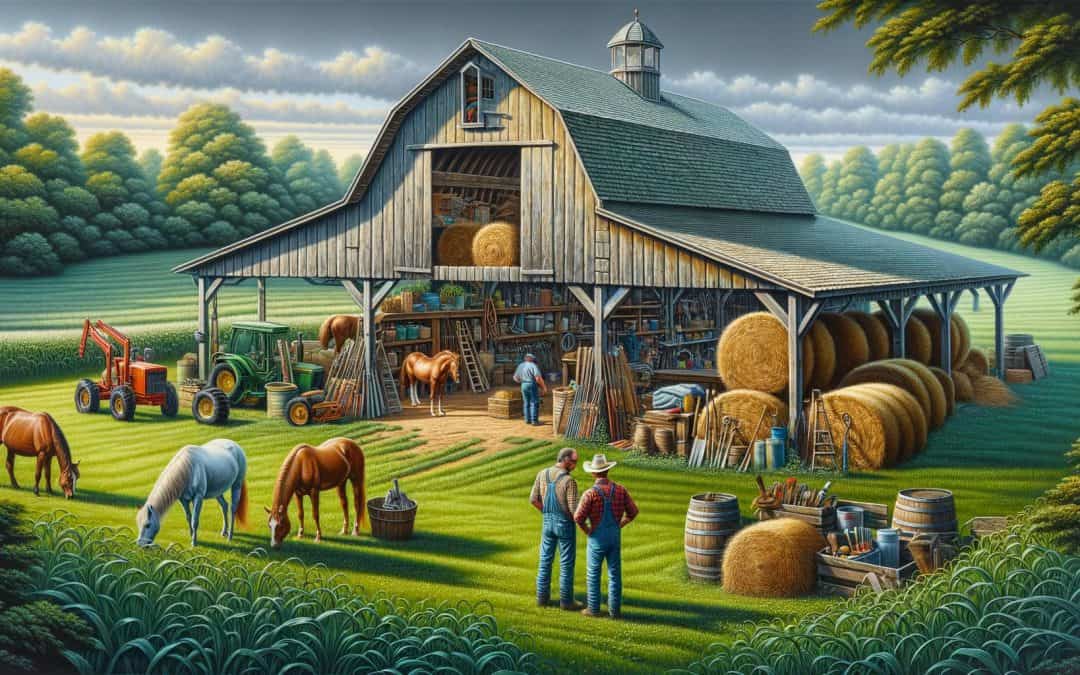Pole barns are versatile structures that have become increasingly popular in recent years. At Outbuilders, we’ve seen firsthand how these buildings can serve a wide range of purposes across various industries.
From agricultural storage to residential workshops and commercial spaces, the question “What are pole barns used for?” has many answers. Let’s explore the diverse applications of these adaptable and cost-effective buildings.
How Do Farmers Use Pole Barns?
Pole barns stand as a farmer’s indispensable asset. These adaptable structures play a key role in modern agriculture, offering cost-effective solutions for various farm needs.
Equipment Storage and Protection
Farmers primarily use pole barns to store and protect valuable farm equipment. Large machinery like tractors, combines, and harvesters (often costing hundreds of thousands of dollars) require shelter from the elements. This protection extends equipment lifespan and reduces maintenance costs.
Livestock Housing
Pole barns provide excellent shelter for livestock. Their open design allows for good ventilation, which is essential for animal health. Farmers can customize pole barns with stalls, feeding areas, and milking parlors to suit different types of animals.
Crop and Feed Storage
Storing crops and animal feed represents another common use for pole barns. Farmers can design these structures with specific features like climate control systems to maintain optimal conditions for different types of produce. Pole barns with proper ventilation and insulation help maintain these conditions.
Farm Workshop
Many farmers transform pole barns into workshops for equipment repairs and maintenance. The open floor plan allows for easy movement of large machinery, while high ceilings accommodate lifts and other repair equipment. Adding features like workbenches, tool storage, and adequate lighting can turn a pole barn into a fully functional repair shop, saving farmers time and money on outsourced repairs.

Pole barns offer farmers a flexible, cost-effective solution for their diverse needs. As agricultural technology continues to advance, these structures will undoubtedly evolve to meet the changing requirements of modern farming. Next, we’ll explore how pole barns serve residential needs, providing homeowners with versatile spaces for various purposes.
How Can Pole Barns Enhance Residential Properties?
Pole barns have transcended their agricultural roots to become versatile additions to residential properties. Homeowners now recognize these structures as practical solutions for various household needs, offering both functionality and value.
Spacious Vehicle and Equipment Storage
Pole barns excel as oversized garages, providing ample space for a variety of vehicles. Their open floor plans allow easy maneuvering of cars, trucks, RVs, and boats. High ceilings accommodate larger vehicles with ease. Many homeowners opt for additional features like epoxy flooring (which simplifies cleaning and maintenance).
Custom Workshops and Hobby Spaces
The flexible design of pole barns makes them ideal for custom workshops or hobby spaces. Woodworkers can install dust collection systems and multiple power outlets, while artists might prioritize natural lighting through strategically placed windows.
Versatile Living Spaces
Pole barns now serve as additional living spaces for many homeowners. These structures transform into guest quarters, home offices, or even full-fledged accessory dwelling units (ADUs). Proper insulation, HVAC systems, and interior finishes turn a pole barn into a comfortable living area.
Efficient Household Storage Solutions
The large, open spaces of pole barns offer excellent solutions for household storage needs. They provide ideal storage for seasonal decorations, outdoor furniture, and other bulky items that clutter the main house. The addition of shelving units and organizational systems can turn a pole barn into a highly efficient storage space.

Pole barns offer homeowners a cost-effective and customizable solution for various residential needs. Their versatility extends beyond simple storage, providing opportunities for creative living spaces and specialized work areas. As we explore the commercial and industrial applications of pole barns in the next section, you’ll see how these structures continue to adapt to diverse requirements across different sectors.
How Pole Barns Revolutionize Commercial and Industrial Spaces
Pole barns have become game-changers in the commercial and industrial sectors, offering unparalleled flexibility and cost-effectiveness. These structures transform how businesses approach their space needs, from expansive warehouses to innovative office environments.
Warehouse and Inventory Management Reimagined
In logistics and inventory management, pole barns excel. Their open floor plans and high ceilings make them ideal for large-scale storage operations. This type of construction offers a variety of benefits, including efficient design, increased energy performance and shorter construction time.

One standout feature is the ease of customization. Businesses can install racking systems, conveyor belts, and automated storage and retrieval systems (AS/RS) without the constraints of load-bearing walls. This flexibility allows for optimized inventory flow and reduced handling times.
Manufacturing and Assembly Processes Transformed
Pole barns reshape manufacturing spaces. Their ability to span large areas without internal supports creates an ideal environment for production lines and assembly processes. According to the National Association of Manufacturers, 75% of manufacturing firms have fewer than 20 employees, highlighting the importance of flexible and efficient spaces for smaller operations.
These structures also accommodate heavy machinery with ease. The robust post-frame construction supports substantial loads, allowing for the installation of overhead cranes and other equipment essential for modern manufacturing.
Inviting Retail Environments Created
Retailers tap into the potential of pole barns to create unique shopping experiences. The open design allows for creative floor layouts and easy reconfiguration as trends change.
The high ceilings of pole barns also provide opportunities for dramatic lighting and signage, enhancing brand visibility. Retailers report that these features contribute to increased dwell time and higher sales per square foot.
Office Spaces Redefined
Pole barns offer innovative solutions for office spaces. The open-concept design allows for flexible layouts, accommodating both collaborative areas and private workspaces. Companies report improved employee satisfaction and productivity in these adaptable environments.
The cost-effectiveness of pole barn construction allows businesses to allocate more resources to interior design and amenities, creating attractive and functional workplaces.
Final Thoughts
Pole barns have proven their versatility across various sectors, answering the question “What are pole barns used for?” with a wide range of applications. These structures adapt to diverse needs, offering solutions for farmers, homeowners, and businesses alike. Their customization options allow property owners to tailor these buildings to specific requirements, from adding insulation for climate control to installing specialized lighting for retail spaces.

The long-term benefits of pole barns for property owners are significant. Their durability ensures a lasting investment, while the flexibility of the space allows for easy repurposing as needs change over time. This adaptability can increase property value and provide ongoing utility for years to come.
At Outbuilders, we specialize in creating high-quality, customized pole barns and other storage solutions. Our expert team in Central Oregon constructs durable and personalized structures on-site, using top-grade materials (backed by a five-year limited warranty). We offer a range of products designed to meet diverse needs, from storage sheds to garages and pole barns.







Trackbacks/Pingbacks